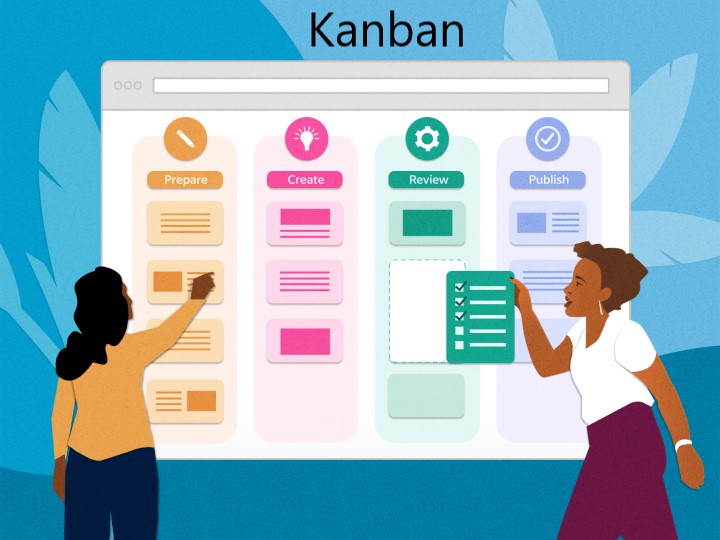
Fundamentals of Kanban
Kanban is a highly effective visual task management system that originated in the Japanese automotive industry. Kanban was developed by Taiichi Ohno at Toyota in the 1940s. It was initially devised as a scheduling system to improve manufacturing efficiency and responsiveness. The word “Kanban” translates to “signboard” or “billboard” in Japanese. This is a nod to the system’s reliance on visual cues to communicate information about what to produce, when to produce it, and how much to produce.
The basic concept of Kanban revolves around visualizing work, maximizing efficiency, and fostering continuous improvement. At its core, the system utilizes elements like Kanban boards, cards, and visual signals to manage work processes. A Kanban board is typically divided into columns that represent different stages of the workflow, such as “To Do,” “In Progress,” and “Completed.” Each task or project is represented by a Kanban card that moves from one column to the next. They visually track the progress of work through the production process. This setup helps teams quickly identify bottlenecks or delays in the workflow.
Kanban cards are central to this system. They contain critical information about the task at hand. This includes details about deadlines, responsible persons, and any other relevant notes. These cards ensure that all team members have a clear understanding of each task’s requirements and status. Moreover, visual signals, such as colors, symbols, or flags on the cards, can indicate different priorities, project types, or special needs, aiding in quick comprehension and decision-making.
Overall, Kanban’s power lies in its simplicity and visual nature, which reduces the complexity of managing multiple tasks and projects. By making the state of the work processes visible, Kanban helps teams optimize the flow of work, minimize waste, and enhance productivity, all while fostering a culture of transparency and accountability.
Benefits of Visual Task Management
Visual task management, as exemplified by Kanban, offers a multitude of benefits that enhance team dynamics and productivity. The use of a visual system like Kanban facilitates a high level of transparency within teams. Each team member can see the status of various tasks in real-time, which helps in identifying what work has been completed and what still needs attention. This transparency not only clarifies individual responsibilities but also fosters a collective understanding of the project’s progress.
Accountability is another critical benefit derived from visual task management. When tasks and their statuses are visible to all team members, individuals are more likely to feel a sense of ownership and responsibility for completing their work on time. Moreover, this visibility allows team leaders and members to hold each other accountable, ensuring that no task falls through the cracks.
Communication within teams also improves significantly with visual task management. Kanban boards serve as a central hub for project information, which can reduce the need for excessive meetings and emails. Team members can quickly gather around the board for updates, discuss bottlenecks, and reassign tasks if necessary, making communication more efficient and targeted.
Enhancing Motivation
From a psychological perspective, visualizing work progress can greatly enhance motivation and satisfaction among team members. Seeing a physical representation of what has been achieved, and what is yet to be completed, can be highly motivating. It provides a clear sense of progress and accomplishment, which boosts morale and encourages teams to push towards project completion.
Furthermore, the productivity benefits of visual task management are substantial. By minimizing the time spent searching for information or clarifying task statuses, teams can focus more directly on the tasks at hand. This streamlined workflow leads to faster completion rates, reduced cycle times, and ultimately, a more agile response to project demands and changes.
In essence, visual task management through Kanban not only optimizes operational efficiency but also strengthens team cohesion by making work processes clear, transparent, and accessible to all involved.
Setting Up a Kanban System
Setting up a Kanban system begins with the selection of the right tools. Teams must decide between a physical Kanban board, which could be as simple as a whiteboard with sticky notes, or a software-based system, which offers digital boards and integrated features suitable for remote or larger teams. The choice depends on the team’s size, location, and workflow needs. Digital tools like Trello, Asana, or Jira offer customizable templates and automation that enhance the scalability and accessibility of Kanban for diverse projects.
Once the tool is selected, the next step is configuring the initial workflow on the Kanban board. This involves creating columns that represent different stages of the workflow process, such as “To Do,” “Doing,” and “Done.” However, these can be customized to reflect more specific stages pertinent to the team’s operations, such as “Design,” “Development,” “Testing,” and “Deployment.” The goal is to visually capture the flow of tasks from inception to completion.
To effectively customize the Kanban system, consider the project scope and team size. For smaller teams or projects, a simpler board with fewer columns might suffice, focusing only on essential stages of the workflow. Larger teams or more complex projects might require additional columns and sub-columns to manage different components of the project effectively. For example, a software development team might use sub-columns under “Testing” for different testing phases like “Unit Testing,” “Integration Testing,” and “User Acceptance Testing.”
Kanban card
Each task in the workflow is represented by a Kanban card. These cards should move from left to right as they progress through the stages on the board. Each card typically contains details about the task, including the task owner, deadlines, and any relevant links or files. It’s crucial to establish clear rules for moving cards from one column to another to maintain consistency and clarity in task management.
Successfully implementing a Kanban system requires thoughtful setup of the board and workflow, tailored to the team’s specific needs. Regular reviews and adjustments ensure the Kanban system remains effective and continues to enhance productivity and transparency within the team.
Common Pitfalls and How to Avoid Them
Implementing a Kanban system offers many benefits, but certain pitfalls can hinder its effectiveness if not addressed. One common challenge is overcomplicating the process. When teams transition to Kanban, there’s a tendency to replicate every detail of their old systems into the new Kanban setup. This often leads to cluttered boards that are hard to manage and slow down productivity.
To avoid this, start with a simple board configuration that reflects only the most critical stages of your workflow. As teams become more accustomed to the Kanban approach, you can gradually introduce more complexity if necessary. This phased approach helps maintain clarity and focus, ensuring that the Kanban system remains a tool for efficiency rather than a source of confusion.
Another typical challenge is misunderstanding the flow of work. Teams new to Kanban might not fully grasp how to manage work in progress effectively, leading to bottlenecks where too many tasks accumulate at certain stages. To combat this, it’s crucial to set clear work in progress (WIP) limits for each stage of the board. WIP limits enforce discipline and help teams focus on finishing current tasks before taking on new ones, which keeps the workflow smooth and continuous.
Training and Workshops
Furthermore, regular training and workshops can enhance team understanding of Kanban’s key principles like flow management and continuous improvement. Education ensures everyone knows how to effectively use the system and appreciate the benefits of adhering to Kanban rules.
In addition, it’s vital to monitor and receive feedback. Regular review sessions enable the team to evaluate the board and address any issues. These discussions can lead to adjustments in work-in-progress limits, board reorganization, or simplification of complex processes.
Overall, Kanban aims to boost productivity and streamline workflows. However, its effectiveness largely depends on proper implementation and maintenance. By starting simply, enforcing clear rules, and adapting based on feedback, organizations can maximize the benefits of Kanban.
Case Studies and Success Stories
The implementation of Kanban across various industries has led to notable success stories that highlight its effectiveness in improving workflow, enhancing team collaboration, and boosting overall productivity. A closer look at these case studies provides valuable insights into how different organizations have tailored Kanban to suit their specific operational needs.
Software Development Company
For example, a software development company, after integrating Kanban into their processes, reported a significant decrease in project completion times. By visualizing their workflow on a Kanban board and implementing WIP limits, the company was able to identify and resolve bottlenecks more efficiently. This adjustment not only sped up their delivery times but also increased the overall quality of their software products, as the team could focus more on quality assurance and less on managing task overload.
Healthcare Provider
Similarly, a healthcare provider used Kanban to manage the administrative aspects of patient care. The transparency of the Kanban system allowed different departments to coordinate more effectively, leading to a smoother patient flow and reduced waiting times. The visual nature of the Kanban board made it easier for staff to track the progress of patient processing and adjust resources dynamically, thereby enhancing the patient experience and optimizing resource allocation.
Marketing Agency
Another case involves a marketing agency that adopted Kanban to manage various campaigns and creative projects. The use of Kanban enabled the team to visually organize and prioritize tasks, which improved internal communication and streamlined project timelines. As a result, the agency experienced a noticeable improvement in meeting client deadlines and an increase in client satisfaction rates.
These examples underscore Kanban’s versatility and its capacity to bring about profound improvements in a range of organizational contexts. By facilitating better visibility of work processes and enabling real-time communication among team members, Kanban helps organizations adapt more swiftly to changes and challenges, ultimately driving greater efficiency and success in their operations.
Conclusion
As we conclude our exploration of Kanban, it’s evident that this system offers significant benefits across various industries. From software development to healthcare and from marketing to manufacturing, Kanban enhances workflow efficiency and improves team collaboration. It has also proven effective in increasing productivity. The system allows teams to visualize work processes, simplifying task management. It also empowers them to make informed, agile decisions that keep projects progressing smoothly.
Moreover, the real-world success stories from companies that have integrated Kanban showcase its effectiveness. These organizations have shown how Kanban can turn chaotic workflows into streamlined processes that yield results. They also help to cultivate a culture of continuous improvement. As teams navigate the fast pace and constant changes of today’s business world, Kanban offers a robust tool. It adapts well and meets these challenges effectively.
In conclusion, Kanban is more than a productivity tool. It is a transformative approach that leads to sustainable business practices and improved operational performance. Whether improving current processes or implementing new ones, considering Kanban could be key to achieving greater success.


